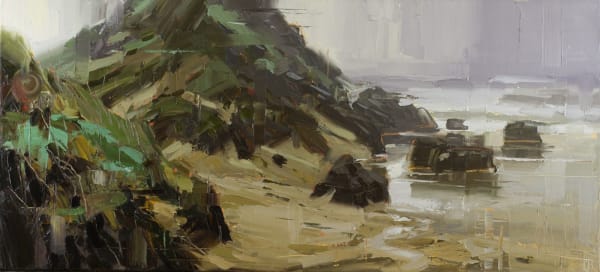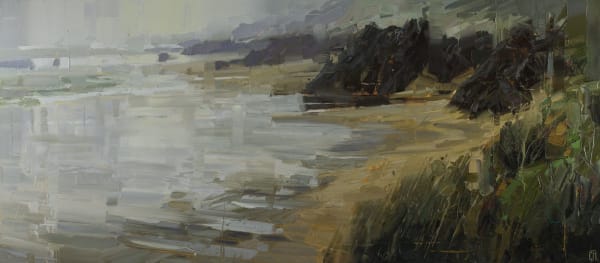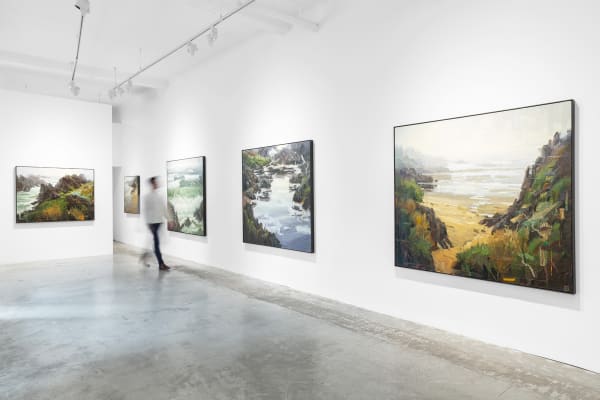Clifford How: Takayna – The Edge of the World
-
 Clifford HowA Place Where the Ocean Finds Rest, 2021oil on linen168 x 183.5 cm, 170 x 185.5 cm (framed)
Clifford HowA Place Where the Ocean Finds Rest, 2021oil on linen168 x 183.5 cm, 170 x 185.5 cm (framed) -
 Clifford HowCoastal Sojourn, 2021oil on linen82 x 87 cm, 84 x 89 cm (framed)
Clifford HowCoastal Sojourn, 2021oil on linen82 x 87 cm, 84 x 89 cm (framed) -
 Clifford HowCove, 2021oil on linen56 x 122 cm, 58 x 124 cm (framed)
Clifford HowCove, 2021oil on linen56 x 122 cm, 58 x 124 cm (framed) -
 Clifford HowDistant Waves Broke the Silence, 2021oil on linen137.5 x 153 cm, 139.5 x 155 cm (framed)
Clifford HowDistant Waves Broke the Silence, 2021oil on linen137.5 x 153 cm, 139.5 x 155 cm (framed) -
 Clifford HowEmpyrean I, 2021oil on linen137.5 x 168.5 cm, 139.5 x 170.5 cm (framed)
Clifford HowEmpyrean I, 2021oil on linen137.5 x 168.5 cm, 139.5 x 170.5 cm (framed) -
 Clifford HowEmpyrean II, 2021oil on linen137.5 x 168.5 cm, 139.5 x 170.5 cm (framed)
Clifford HowEmpyrean II, 2021oil on linen137.5 x 168.5 cm, 139.5 x 170.5 cm (framed) -
 Clifford HowEmpyrean III, 2021oil on linen87 x 82 cm, 89 x 84 cm (framed)
Clifford HowEmpyrean III, 2021oil on linen87 x 82 cm, 89 x 84 cm (framed) -
 Clifford HowI Was Faced Into the Southern Fury, 2021oil on linen81.7 x 87 cm, 83.5 x 89 cm (framed)
Clifford HowI Was Faced Into the Southern Fury, 2021oil on linen81.7 x 87 cm, 83.5 x 89 cm (framed) -
 Clifford HowIt Was a Brief Moment Between Showers, 2021oil on linen61.5 x 56 cm, 63.5 x 58 cm (framed)
Clifford HowIt Was a Brief Moment Between Showers, 2021oil on linen61.5 x 56 cm, 63.5 x 58 cm (framed) -
 Clifford HowLittoral I, 2021oil on linen86.5 x 82 cm, 88.5 x 84 cm (framed)
Clifford HowLittoral I, 2021oil on linen86.5 x 82 cm, 88.5 x 84 cm (framed) -
 Clifford HowLittoral II, 2021oil on linen137.5 x 153 cm, 139.5 x 155 cm (framed)
Clifford HowLittoral II, 2021oil on linen137.5 x 153 cm, 139.5 x 155 cm (framed) -
 Clifford HowOcean Garden, 2021oil on linen57 x 122 cm, 59 x 124 cm (framed)
Clifford HowOcean Garden, 2021oil on linen57 x 122 cm, 59 x 124 cm (framed) -
 Clifford HowProcession, 2021oil on linen168 x 183.5 cm, 170 x 185.5 cm (framed)
Clifford HowProcession, 2021oil on linen168 x 183.5 cm, 170 x 185.5 cm (framed) -
 Clifford HowRhythmic Pulse, 2021oil on linen122 x 153 cm, 124 x 155 cm (framed)
Clifford HowRhythmic Pulse, 2021oil on linen122 x 153 cm, 124 x 155 cm (framed) -
 Clifford HowRoar, 2021oil on linen199 x 214 cm, 201 x 216 cm (framed)
Clifford HowRoar, 2021oil on linen199 x 214 cm, 201 x 216 cm (framed) -
 Clifford HowRoaring Forties, 2021oil on linen168 x 183.5 cm, 170 x 185.5 cm (framed)
Clifford HowRoaring Forties, 2021oil on linen168 x 183.5 cm, 170 x 185.5 cm (framed) -
 Clifford HowRock Pool – First Light, 2021oil on linen168 x 183.5 cm, 170 x 185.5 cm (framed)
Clifford HowRock Pool – First Light, 2021oil on linen168 x 183.5 cm, 170 x 185.5 cm (framed) -
 Clifford HowSquall, 2021oil on linen56 x 56 cm, 58 x 58 cm (framed)
Clifford HowSquall, 2021oil on linen56 x 56 cm, 58 x 58 cm (framed) -
 Clifford HowSurge II, 2021oil on linen51 x 56.5 cm, 53 x 58.5 cm (framed)
Clifford HowSurge II, 2021oil on linen51 x 56.5 cm, 53 x 58.5 cm (framed) -
 Clifford HowTakayna, 2021oil on linen199 x 214 cm, 201 x 216 cm (framed)
Clifford HowTakayna, 2021oil on linen199 x 214 cm, 201 x 216 cm (framed) -
 Clifford HowThe Concealed Beach, 2021oil on linen168 x 183.5 cm, 170 x 185.5 cm (framed)
Clifford HowThe Concealed Beach, 2021oil on linen168 x 183.5 cm, 170 x 185.5 cm (framed) -
 Clifford HowThe Weathered Cove, 2021oil on linen66.5 x 56 cm, 68.5 x 58 cm (framed)
Clifford HowThe Weathered Cove, 2021oil on linen66.5 x 56 cm, 68.5 x 58 cm (framed) -
 Clifford HowTimeless Motion, 2021oil on linen107 x 112 cm, 109 x 114 cm (framed)
Clifford HowTimeless Motion, 2021oil on linen107 x 112 cm, 109 x 114 cm (framed) -
 Clifford HowWhere Few Have Walked, 2021oil on linen82 x 183.5 cm, 84 x 185.5 cm (framed)
Clifford HowWhere Few Have Walked, 2021oil on linen82 x 183.5 cm, 84 x 185.5 cm (framed) -
 Clifford HowWhere the Departed Once Walked, 2021oil on linen51 x 56 cm, 53 x 58 cm (framed)
Clifford HowWhere the Departed Once Walked, 2021oil on linen51 x 56 cm, 53 x 58 cm (framed)
Clifford How’s previous paintings took us on a journey to the Tasmanian Central Highlands. In these new landscapes, 'Takayna – The Edge of the World', he takes us on another journey, to the dramatic coastline of Tasmania’s north-west Tarkine region.
But ‘journey’ is a word suffering from over-use. It suggests that paintings are like picture postcards which, like some hypnotist’s accessory, can transport us imaginatively off to some other place. Well, actually they do. But perhaps there is a more significant journey involved.
In the 19th Century, photography liberated painting from its evidentiary obligations, so that a portrait or a landscape could be far more interesting than just a document. Not that painting had ever been just documentation, but it could now focus more on triggering an experience than on optical reproduction.
This is true of How’s landscapes which are less about representing the landscape than the experience of being in that landscape. Key to this is how he builds up the surface using a palette knife.
This process employs what he calls “minimal touches”, creating a kind of abstraction, which the viewer has to ‘read’. The viewer is a participant, constantly responding to the tension between what is being represented and how it is represented. In this way, we don’t so much see a reproduction of the landscape, but experience it directly.
Of course, realism is itself an illusion – first explored by the Barbizon school and the Impressionists whose landscapes changed as the light changed. How is also fascinated by this mutability – in this case by the mercurial weather of North West Tasmania and how it constantly transforms the landscape.
The previous landscapes had a Corot-like stillness. Despite their inherent drama, nature comes across as a nurturing embrace. Not so these new paintings which depict the wild collision of land and sea. Mediated by the volatile weather of the Southern Ocean, the fractious sea confronts the timeless resistance of a rocky coast, a drama leavened occasionally by a protected rock pool or secluded beach.
Key to this drama is the palette knife. Its directionality, materiality and edginess serve to embody the dramatic tensions portrayed.
Usually the palette knife is part of an expressive technique. In How’s case it is more about building up an abstract matrix of marks which he then selectively strips away so that the inner heart of the painting projects out, creating the illusion of surface highlights, the classic abstract ‘push-pull’ tension between foreground and background – in these new paintings between the verticality of the rocks and the horizontality of the sea, between the surface and what lies beneath, between the energy of the moment and monumental stillness. We are invited into this process. There is no sleight of hand: this is a painting, not an illusion. The landscape, which we feel as much as see, is just the occasion of the painting.
So, the real journey is in the painting itself as it discovers what it wants to be, not in what it depicts. And the value of any journey lies in the new experiences it offers. Hence, How’s shift in location. With the previous landscapes he was, he says, “getting a bit too comfortable”. The best journeys are always fresh and a little uncomfortable.
Paul McGillick































